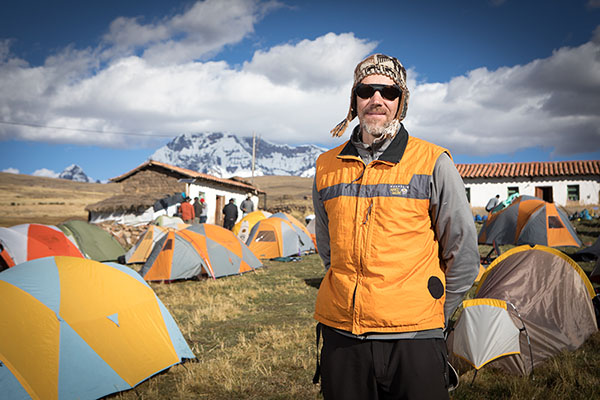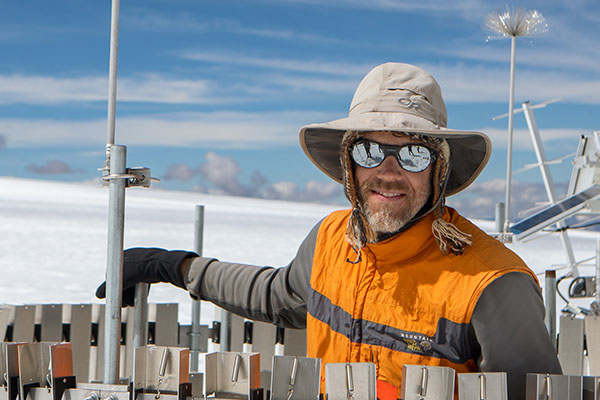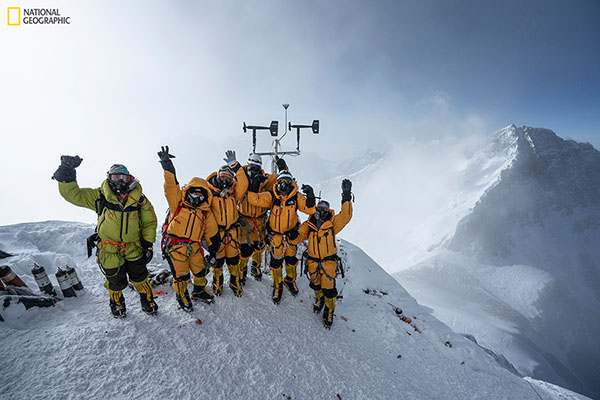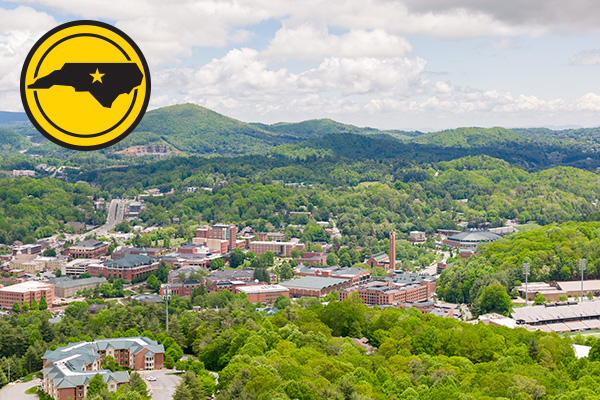
This image, taken from the front cover of the March 11 North Carolina Climate Science Report, shows scenes from the state’s three geographic regions, pictured from left to right: the Western Mountains, the Piedmont and the Coastal Plain. Appalachian’s Dr. Baker Perry, professor in the Department of Geography and Planning, served as a co-author on the report, contributing his expertise to the report’s snowstorms and snow cover sections. North Carolina Institute for Climate Studies image
BOONE, N.C — Rising temperatures and sea levels, increased rains and subsequent flooding, and increased humidity throughout the state are indicated for North Carolina for the foreseeable future, according to the North Carolina Climate Science Report (NCCSR) released March 11.
The report is a scientific assessment of historical climate trends and potential future climate change in North Carolina under increased greenhouse gas concentrations and was compiled by climate science experts from across the state. Dr. Baker Perry, professor in Appalachian State University’s Department of Geography and Planning, served as a co-author on the report, contributing specific expertise to the snowstorms and snow cover sections.
The report, led by the North Carolina Institute for Climate Studies (NCICS), is the first of its kind and presents findings for both the state of North Carolina as a whole and for each of the state’s three geographic regions: the Coastal Plain, the Piedmont and the Western Mountains.
A summary of the report states: “The continuing release of heat-trapping gases into the atmosphere as a result of human activity makes for a warmer, wetter and more humid North Carolina. Scientists from across the state agree that the changes to our climate in this century will be larger than anything experienced in North Carolina’s historical past.
The summary continues, “Climate change will impact our state’s economy, environment and people. Over the next 80 years, the state can expect disruptive sea level rise, increasingly hot nights and more days with dangerous heat and extreme rainfall unless the global increase in heat-trapping gases is stopped.”
The report also includes chapters on sea level rise, trends involving interactions of multiple aspects of the climate system (including inland flooding, wildfire, forest ecosystem changes, urban heat island effects and air pollution), and findings relevant to engineering design standards.
Data collected from weather stations supported by Appalachian and located on Poga Mountain, Beech Mountain, Roan Mountain and Grandfather Mountain, as well as those installed on Appalachian’s campus, contributed to the findings of the report, Perry said.
Although the Peru, Bolivia and Nepal weather stations, which Perry has been instrumental in developing, installing and maintaining, did not contribute directly to the report, Perry said these stations are “providing critical data for how climate is changing at the highest elevations of the planet, where observations are most limited.”
The report was prepared in response to a request from the North Carolina Department of Environmental Quality as part of the state’s response to Gov. Roy Cooper’s 2018 Executive Order 80.
The Climate Science Advisory Panel consisted of North Carolina State University (NC State) and federal research scientists with national and international reputations in their specialty areas of climate science. The author team comprised NCICS scientists and several members of the advisory panel.
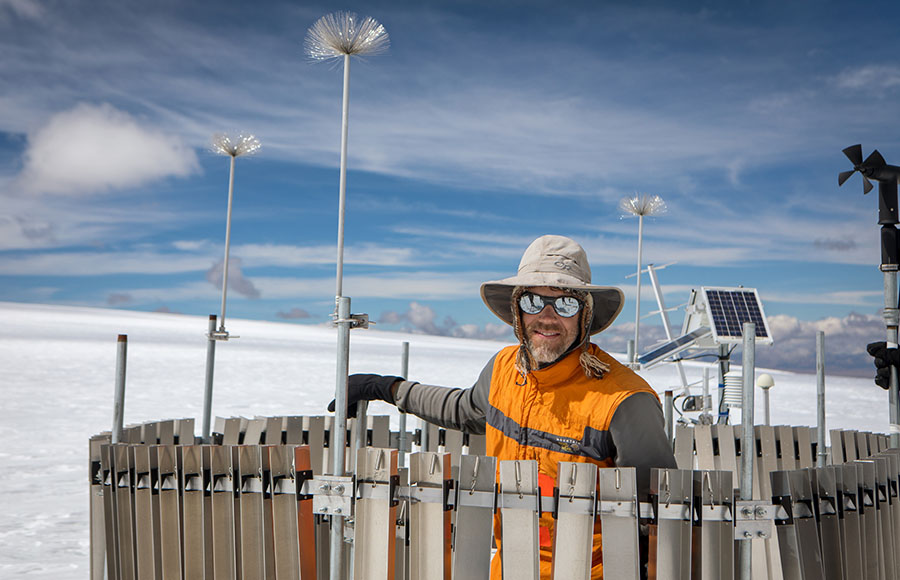
Dr. Baker Perry, professor in Appalachian’s Department of Geography and Planning, at the weather station he installed on the Quelccaya Ice Cap in Peru. Perry co-authored the recent North Carolina Climate Science Report (NCCSR), which was informed by stations such as this one. Photo by Marie Freeman
Perry said the development of the report, which began in June 2019, was highly collaborative. He credited lead authors Dr. Ken Kunkel, NCICS lead scientist for assessments and NC State research professor, and Dr. David Easterling, chief of the Scientific Services Division at National Oceanic and Atmospheric Administration’s (NOAA) National Centers for Environmental Information (NCEI), for soliciting input on the report outline, working with the other co-authors on the respective sections and coordinating the peer-review process.
“It was a real privilege to collaborate so closely with such an outstanding team of scientists,” Perry said. “I learned a considerable amount along the way.”
Implications for Western North Carolina are reported independently of the state but indicate temperature and precipitation trends in the three regions of the state are generally similar to statewide trends.
In the mountains, there is no centurylong trend in snowfall, although stations in the southern mountains have seen decreasing trends over the last 50 years. According to the report, conditions favorable for snow-cover maintenance and snowmaking in the Western Mountains have been highly variable since 1981, but recent years have seen below average percentages of time when conditions are favorable.
“Future climate projections indicate that the High Country will likely experience an increase in winter temperature and decreases in snowfall and snow cover duration, which will likely impact winter tourism,” Perry said. “Summer temperatures are also projected to increase, which will result in higher demand for air conditioning.”
The report leverages the expertise of NOAA’s Assessments Technical Support Unit (TSU), which is staffed primarily by NCICS, and applies the methodologies and processes developed for the National Climate Assessment.
The report underwent several rounds of review and revision, including an anonymous peer review organized by the NCEI.
What do you think?
Share your feedback on this story.
About the Department of Geography and Planning
The Department of Geography and Planning promotes the understanding of the spatial dimensions of human behavior within the physical and cultural systems of the earth, and the role of planning in achieving improvement in those systems. The department offers degrees in geography and in community and regional planning. Learn more at https://geo.appstate.edu.
About the College of Arts and Sciences
The College of Arts and Sciences (CAS) at Appalachian State University is home to 17 academic departments, two centers and one residential college. These units span the humanities and the social, mathematical and natural sciences. CAS aims to develop a distinctive identity built upon our university's strengths, traditions and locations. The college’s values lie not only in service to the university and local community, but through inspiring, training, educating and sustaining the development of its students as global citizens. More than 6,800 student majors are enrolled in the college. As the college is also largely responsible for implementing App State’s general education curriculum, it is heavily involved in the education of all students at the university, including those pursuing majors in other colleges. Learn more at https://cas.appstate.edu.
About Appalachian State University
As a premier public institution, Appalachian State University prepares students to lead purposeful lives. App State is one of 17 campuses in the University of North Carolina System, with a national reputation for innovative teaching and opening access to a high-quality, cost-effective education. The university enrolls more than 21,000 students, has a low student-to-faculty ratio and offers more than 150 undergraduate and 80 graduate majors at its Boone and Hickory campuses and through App State Online. Learn more at https://www.appstate.edu.
![NC Climate Report Shows Warming Temperatures, Rising Sea Levels [faculty featured]](/_images/_posts/2020/05/nc-climate-report-shows-600x400.jpg)
